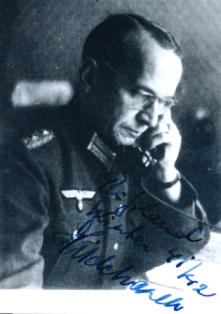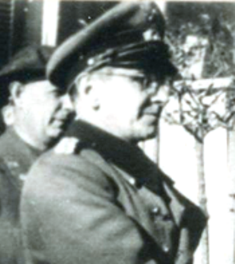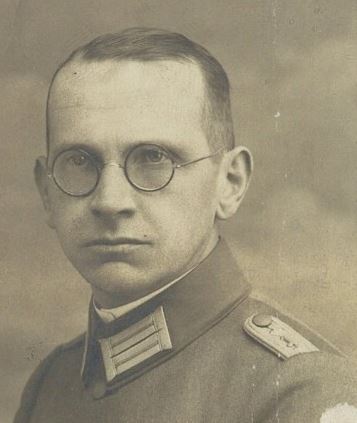Hildebrandt, Hans-Georg (Generalleutnant)
- Date of birth:
- June 15th, 1896 (Fraustadt-Lebus/Brandenburg, Germany)
- Date of death:
- January 31st, 1967 (Frankfurt am Main/Hesse, Germany)
- Nationality:
- German
Biography
Hans-Georg Hildebrandt served as Ia 14.Panzerkorps, with Stab 34. Panzerkorps, XXXIX.Armeekorps, 21. Panzer-Division and with 715. Infanterie-Division. He finally reached the rank of Generalleutnant and was a POW to the British from May 3rd, 1945 until November 1st, 1947.
Promotions:
10.08.1914: Fähnrich
14.10.1914: Leutnant
31.07.1925: Oberleutnant
01.01.1931: Hauptmann
01.12.1935: Major
01.10.1938: Oberstleutnant
01.10.1940: Oberst
01.03.1943: Generalmajor
20.08.1944: Generalleutnant
Career:
10 August 1914: Entered the Army as a Fähnrich in the Füsilier-Regiment General-Feldmarschall Graf Blumenthal (1. Magdeburgisches) Nr.36 after passing out from the Prussian Cadet Corps.
21 December 1914: Adjutant of the III. Battalion of Fusilier Regiment 36.
5 December 1915: Transferred to the Replacement Battalion of Fusilier Regiment 36.
3 January 1916: Adjutant of the Recruit Battalion of the 113th Infantry Division.
29 February 1916-21 April 1916: At the same time, detached as an Ordonnanz-Offizier to the 225th Infantry Brigade.
27 July 1916: Leader of the 13th Company of Fusilier Regiment 36.
20 August 1916: Assistant Signals Officer on the staff of the 225th Infantry Brigade.
20 May 1917: Transferred to Telephone Construction Platoon 837 and detached to the Signals School at Spandau-Ruhleben.
1 July 1917: Leader of Telephone Construction Platoon 995.
10 October 1917: Commander of Telephone Battalion 207.
15 June 1918: Detached as a Technical Instructor to the Reserve Officer Course at Floresse near Namur.
4 September 1918: Detached as Technical Leader to the Fähnrich Course at Floresse near Namur.
17 November 1918: Transferred to the Guard Signals Battalion.
7 January 1919: Commander of the Telephone Battalion of Freikorps "Hülsen." [Like other Freikorps units, this volunteer organization, commanded by Generalleutnant Walter von Hülsen, took part in defeating Communist uprisings and maintaining law and order throughout Germany in the aftermath of World War I.]
1 May 1919: Leader of Telephone Battalion 203.
1 May 1920: Adjutant of Signals Battalion 3.
1 October 1920: Transferred to Brigade Motorized Battalion 15 and detached to Brigade Motorized Battalion 8.
1 January 1921: Transferred to the 3rd (Prussian) Motorized Battalion upon the formation of the new Reichsheer from the Übergangsheer or Transitional Army.
31 May 1921: Transferred to the Motorized Personnel of the 3rd (Prussian) Medical Battalion.
5 July 1921: Returned to the 3rd (Prussian) Motorized Battalion.
1 October 1922: Adjutant of the 3rd (Prussian) Motorized Battalion.
1 April 1924: Transferred to the 7th (Prussian) Reiter [Mounted]-Regiment and detached to the staff of Group Command 1.
2 October 1925-15 February 1926: Detached to the Weapons School Course in Dresden.
1 April 1927: Detached to the 9th (Prussian) Infantry Regiment.
1 October 1927: Detached for Leader Assistant training with the staff of the 1st Division.
1 June 1928-30 September 1928: At the same time, detached to the 3rd (Prussian) Artillery Regiment.
1 July 1929-25 September 1929: At the same time, detached to the 4th (Saxon) Signals Battalion.
1 October 1929: Transferred to the 2nd (Prussian) Artillery Regiment.
1 October 1930: Detached to the 9th (Prussian) Infantry Regiment and to the Reich Archive.
1 February 1931: Chief of the 1st Company of the 1st (Prussian) Motorized Battalion.
1 October 1934: Transferred to the staff of the Königsberg Reichswehr Central Military Staff.
1 May 1935: Transferred to the General Staff of the Königsberg Regional Recruitment Inspectorate.
2 July 1936: Operations Officer (Ia) in the General Staff of the 1st Panzer Division, Weimar.
21 February 1938: Detached to the General Staff of Group Command 4.
10 November 1938: Operations Officer (Ia) in the General Staff of the XIV Army Corps (Motorized). [Commanded by General der Infanterie Gustav von Wietersheim, the corps took part in the invasion of Poland in September 1939 and the invasion of France and the Low Countries in May-June 1940.]
20 September 1940: Chief of the General Staff of the XXXIX Army Corps (Motorized); redesignated the XXXIX Panzer Corps on 9 July 1942. [Concentrated in southern France, General der Panzertruppe Rudolf Schmidt’s XXXIX Army Corps (Motorized) was held in readiness for a supporting role in Operation "Felix," the proposed German assault on Gibraltar.[1] In May 1941, the corps transferred to East Prussia in preparation for Operation "Barbarossa," the invasion of the Soviet Union. Jumping off on 22 June 1941, the corps took part in the initial drive across central Russia under Army Group Center. Transferred to Army Group North in late-August 1941, Schmidt’s corps participated in the encirclement of Leningrad before establishing itself along the Volkhov River. Two days after Schmidt’s troops had captured Tikhvin on 9 November 1941, Generalleutnant (later General der Panzertruppe) Hans-Jürgen von Arnim assumed leadership of the corps.[2] Forced back to the Volkhov under pressure from a fierce Russian counteroffensive, the XXXIX Army Corps (Motorized) continued to cling to its positions throughout the winter. After being withdrawn from the Volkhov front, the corps punched through the Russian lines and relieved the encircled German garrison at Cholm in early May 1942. Led by Generalmajor Theodor Scherer, commander of the 281st Security Division, the 5,000-man garrison had been cut off and under siege since January of that year.]
29 September 1942: Army High Command Leader Reserve.
1 January 1943: Delegated with the leadership of the 21st Panzer Division in North Africa. [Oberst Hildebrandt assumed leadership of the 21st Panzer Division following the death of the commander, Generalmajor Heinz von Randow, by a British mine near Tripoli on 21 December 1942. From 14-15 February 1943, the 21st Panzer Division along with Generalmajor (later Generalleutnant) Friedrich (Fritz) Freiherr von Broich’s 10th Panzer Division, savaged the U.S. 1st Armored Division at the Battle of Sidi bou Zid inflicting over 1,600 casualties and destroying almost 100 tanks and 29 artillery pieces.[3] Jumping off from Sbeïtla, the 10th and 21st Panzer Divisions renewed the German offensive and, from 19-22 February 1943, engaged in the Battle of Kasserine Pass. As the 10th Panzer Division moved in two columns toward Thala and Tébessa (Algeria) via the Kasserine Pass, Hildebrandt’s division advanced north along Highway 71 toward Le Kef. However, strong Allied reserves finally halted the advance and turned the tide against the German offensive. After falling ill, Hildebrandt was succeeded by Oberst (later Generalmajor) Heinrich-Hermann von Hülsen who led the division until surrendering it to the British in Tunisia on 13 May 1943.]
1 March 1943: Commander of the 21st Panzer Division in North Africa.
1 March 1943-15 March 1943: Sick leave.
15 March 1943: Army High Command Leader Reserve.
24 August 1943: Detached to the Army High Command/assigned to the General Quartermaster to perform a special duty assignment.
1 November 1943: At the disposal of the Inspector General of Panzer Troops – Instructor at the Panzer Troop School.
15 January 1944: Commander of the 715th Infantry Division in Italy.
18 September 1944: Army High Command Leader Reserve – sick.
1 October 1944-30 April 1945: Commander of the German Liaison Staff 182 assigned to the Italian Social Republic’s 3rd Marine Infantry Division "San Marco." [Commanded by Generale di Divisione Amilcare Farina, the division served as a component of General der Artillerie Kurt Jahn’s Lombardy Corps in Italy.[4] During its existence from 1 September 1944-1 May 1945, the Italo-German Lombardy Corps served alternately under Maresciallo d’Italia Rudolfo Graziani’s Ligurian Army and the German 14th Army.]
3 May 1945-1 November 1947: Prisoner of war in British captivity.
10th June 1947 transferred from Rimini to Island Farm Special Camp 11
1st October 1947 transferred to Camp 186
2nd October 1947 repatriated
Do you have more information about this person? Inform us!
- Period:
- First World War (1914-1918)
- Awarded on:
- October 25th, 1914
- Period:
- First World War (1914-1918)
- Rank:
- mit Schwertern
- Awarded on:
- September 4th, 1915
Swords versión.
- Period:
- First World War (1914-1918)
- Awarded on:
- May 10th, 1917
- Period:
- First World War (1914-1918)
- Awarded on:
- 1934
- Period:
- First World War (1914-1918)
- Awarded on:
- March 1st, 1937
- Period:
- First World War (1914-1918)
- Awarded on:
- April 13th, 1937
- Unit:
- Ia, Generalstab, XIV. Armee-Korps (mot.)
- Awarded on:
- 1939
- Period:
- Second World War (1939-1945)
- Awarded on:
- September 28th, 1939
- Period:
- Second World War (1939-1945)
- Awarded on:
- June 3rd, 1940
- Period:
- Second World War (1939-1945)
- Rank:
- Oberst im Generalstab (Colonel to the General Staff)
- Unit:
- Chef des Generalstabes, XXXIX. Armeekorps (motorisiert), Heer
- Awarded on:
- August 28th, 1941
- Period:
- Second World War (1939-1945)
- Rank:
- Oberst im Generalstab (Colonel to the General Staff)
- Unit:
- Chef des Generalstabes, XXXIX. Armeekorps (motorisiert), Heer
- Awarded on:
- January 26th, 1942
- Period:
- Second World War (1939-1945)
- Awarded on:
- July 13th, 1942
- Period:
- Second World War (1939-1945)
- Awarded on:
- March 30th, 1943
- Period:
- Second World War (1939-1945)
- Awarded on:
- January 17th, 1944
Sources
- Photo 3:
- - PATZWALL, K. & SCHERZER, V., Das Deutsche Kreuz 1941-1945, Band II, Verlag Klaus D. Patzwall, Norderstedt, 2001.
- Scheibert, Horst. Die Träger der Ehrenblattspange des Heeres und der Waffen-SS/ Die Träger der Ehrentaffelspange der Kriegsmarine/ Die Inhaber des Ehrenpokals für Besondere Leistung im Lukftkrieg. Friedberg, Ger.: Podzun-Pallas Verlag, 1986, ISBN 3-7909-0283-7
- Axis History Forum via Awardholders / unit
- NARA Roll T-78 R887
- geocities.ws
- Generale des Heeres 1939-1945























